| Proven Winners? Color Choice? |
September 17, 2010
Dear Customers:
The Following Proven Winners? Color Choice? Is A Partial Selection Of Plants We Now Have Available
NOTICE: Federal law strictly prohibits the asexual propagation of patented plants, without a license. State and/or federal law prohibits the unauthorized use of a trademark.
|
| Cityline? Paris ? Hydrangea |
Growing Tips
Best in well-drained soil that has been amended with peat moss, leaf mold or compost. Flourishes by the ocean. Prune immediately after flowering, blooms on old wood. (Sets flower buds the summer prior to blooming). Prefers high moisture; moist soils are a necessity for this plant. Fertilize in early spring by applying a slow release fertilizer specialized for trees and shrubs. Follow the label for the recommended rate of application. Flower color is affected by pH. For blue flowers, the soil must be more acidic and for pink flowers the soil must be more alkaline.
Exposure
Plant in sun or partial shade
Height
12-36"
Spacing
36-48"
Hardy Temp
-20?F (-29?C)
Uses
Great landscape plant adds a dash of bright color. Good in groupings or masses, in a perennial or shrub borders, as a specimen, screen or hedge. Use in mixed containers, containers, and as a cut flower.
Features
Intense pink-red summer flowers are long lasting and change to green as they age. Prune to shape after flowering (rarely needed) Protect overwinter in north. Mildew resistant. Dwarf. Soil pH will affect flower color.
Awards Won
2007 - Way Hot 100
-Garden Design
|
Cityline? Berlin
Hydrangea macrophylla
Bigleaf Hydrangea
|
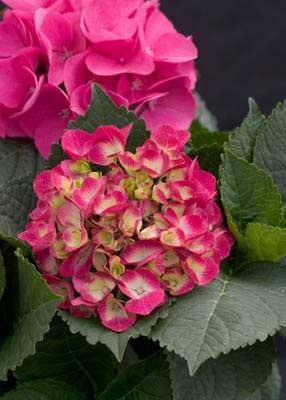 |
| Photo courtesy of Proven Winners - www.provenwinners.com |
|
|
Tired of floppy, weak stemmed hydrangeas, especially when they?re in full bloom? This new and improved hybrid from Germany has tight sturdy stems. This maintenance free plant will require no pruning and that results in more flowers the next coming summer. Its intense fuchsia color will pop in your garden and fill your home with beautiful fresh or dried cut flowers. The flowers age quite nicely into fall as well.
|
Growing Tips
Prune to shape after flowering. Flowers set on previous season's growth, so do not prune severely. Protect overwinter in harsh climates. Blooms may be changed to blue by adding aluminum sulfate to the soil. Grows best in moist, well drained soil. Supplemental water may be needed in very hot weather. May do better in part shade in very hot climates.
Exposure
Plant in sun or partial shade
Height
24-48"
Spacing
36-60"
Hardy Temp
-20?F (-29?C)
Uses
Excellent for mixed borders and cutting gardens.
Features
Large, distinctive summer flowers. Prune to shape after flowering. Protect overwinter in north. Good cut flower. Glossy foliage. Bloom color is affected by soil pH.
|
Edgy? Hearts
Hydrangea macrophylla
Hydrangea
|
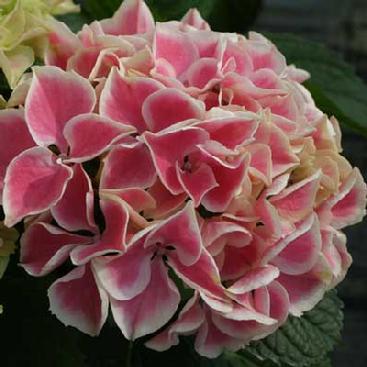 |
| Photo courtesy of Proven Winners - www.provenwinners.com |
|
|
Large intense blooms with dark, pinkish-red flowers accented by a thin white line along the margin. This small to medium sized plant has strong stems and glossy foliage, and the flowers are good for cutting. Flower color can be pushed to blue with the addition of aluminum sulfate to the soil.
|
| Blue Bunny? - Bracted Hydrangea |
Growing Tips
Little needed. Trim lightly in spring or fall. Requires moist, well drained soil. Supplemental watering may be needed in very hot weather. May do better in part shade in the south.
Exposure
Plant in sun or partial shade
Height
24-48"
Spacing
36-60"
Hardy Temp
-10?F (-23?C)
Uses
An elegant addition to mixed beds.
Features
Blue lacecap flowers appear reliably every summer. Prune to shape after flowering. Blooms on new wood. Abundant flowers. Color is not affected by soil pH.
|
Blue Bunny?
Hydrangea involucrata
Bracted Hydrangea
|
|
|
Blue Bunny hydrangea is a drift of blue flowers from mid-summer until fall. It forms its flowers buds on new wood and so blooms reliably every year. Blue Bunny is a strong growing plant that produces an abundance of distinctive blue flowers.
|
| Blush Satin? - Rose of Sharon |
Growing Tips
Blooms mid-summer. Grows in any soil unless it is either very dry or very wet. Prune in late fall or early spring. Can be heavily pruned. Prefers medium moisture. Fertilize in early spring by applying a slow release fertilizer specialized for trees and shrubs. Follow the label for recommended rate of application. A supplemental dose of liquid fertilizer may be needed in mid summer.
Exposure
Full sun
Height
96-144"
Spacing
60-84"
Hardy Temp
-20?F (-29?C)
Uses
An excellent hardy hibiscus for the landscape. Can be trained into a small tree. Excellent for use in mixed containers and then removed for fall garden planting. Use in the mixed border or as a hedge.
Features
An adaptable plant with soft pink flowers in late summer. May be pruned to shape in spring. Easy to grow. Deer resistant. Attracts butterflies.
Awards Won
2005 - Top Pick
-Dallas Arboretum
- Award of Recommendation
-Royal Boskoop Horticulture Society
|
Blush Satin?
Hibiscus syriacus
Rose of Sharon
|
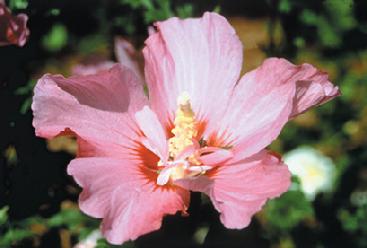 |
| Photo courtesy of Proven Winners - www.provenwinners.com |
|
|
Large, single, soft blushing pink flowers with a prominent eye appear in late summer. Strong growing and long blooming, this is an easy to grow, adaptable plant that will thrive in most gardens.
|
| Blue Chiffon? - Rose of Sharon |
Growing Tips
Blooms in late summer. Grows in any soil unless it is either really wet or dry. Prune in late fall or early spring. Can be heavily pruned, but this is not usually necessary. Prefers medium moisture. Fertilize in early spring by applying a slow release fertilizer specialized for trees and shrubs. Follow the label for recommended rate of application. An additional dose of liquid fertilizer may be needed in summer.
Exposure
Full sun
Height
96-144"
Spacing
72-84"
Hardy Temp
-20?F (-29?C)
Uses
Late season color, hedges, perennial or shrub borders, specimen and containers. This is a nice addition to the mixed border, and can also be used as a specimen plant for late summer interest. Excellent for hedging.
Features
Large blue flowers in late summer. May be pruned to shape in spring. Adaptable and easy to grow. Deer resistant. Attracts butterflies.
Awards Won
- Silver Medal
-Royal Boskoop Horticulture Society
|
Blue Chiffon?
Hibiscus syriacus
Rose of Sharon
|
|
|
The Chiffon series just got more exciting with the addition of this selection with rich blue flowers. It has the same great Chiffon vigorous growth and lacy blooms. Large, single blue flowers adorned with a lacy center to create an anemone-like bloom. Bold yet delicate, Blue Chiffon is a star in the garden from late summer to fall.
|
| Sugar Tip? - Rose of Sharon |
Growing Tips
Grows in any soil unless it is either very dry or very wet. Prune in late fall or early spring. Can be heavily pruned. Prefers medium moisture. Fertilizer in early spring by applying a slow release fertilizer specialized for trees and shrubs. Follow the label for recommended rate of application. A supplemental dose of liquid fertilizer may be needed in mid-summer. This plant is slower growing than other rose of sharon.
Exposure
Full sun
Height
96-144"
Spacing
60-84"
Hardy Temp
-15?F (-26?C)
Uses
Late season color, hedges or screens, perennial or shrub borders, specimen and containers. May be planted in a container as a patio plant and then transplanted into the ground in fall.
Features
Variegated foliage is attractive all season, and soft pink blooms in summer. May be pruned to shape in spring. Deer resistant. Attracts butterflies. Non-invasive.
Awards Won
2009 - Bronze Award
-Royal Boskoop Horticulture Society
|
Sugar Tip?
Hibiscus syriacus
Rose of Sharon
|
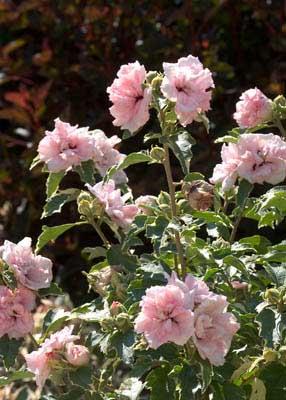 |
| Photo courtesy of Proven Winners - www.provenwinners.com |
|
|
An eye-catching, new Rose of Sharon with brightly variegated creamy-white and bluish-green foliage. Unlike 'Purpureus Variegatus' this beauty actually flowers! It produces loads of clear pink, double flowers and does not produce seed like older cultivars. This is a beautiful plant that will look great in your garden all summer.
|
| Blue Satin? - Rose of Sharon |
Growing Tips
Blooms mid-summer. Grows in any soil unless it is either very dry or very wet. Prune in late fall or early spring. Can be heavily pruned, although this is usually unnecessary. Prefers medium moisture. Fertilize in early spring by applying a slow release fertilizer specialized for trees and shrubs. Follow the label for recommended rate of application. A supplemental dose of liquid fertilizer may be needed in mid-summer.
Exposure
Full sun
Height
96-144"
Spacing
60-84"
Hardy Temp
-20?F (-29?C)
Uses
An excellent Hardy Hibiscus for the landscape. Can be trained into a small tree. Excellent for use in mixed containers and then removed for fall planting. Good for hedging.
Features
Large blue flowers in late summer. May be pruned to shape in spring. Adaptable and easy to grow. Deer resistant. Attracts butterflies.
Awards Won
2005 - Top Pick
-Dallas Arboretum
- Award of Recommendation
-Royal Boskoop Horticulture Society
|
Blue Satin?
Hibiscus syriacus
Rose of Sharon
|
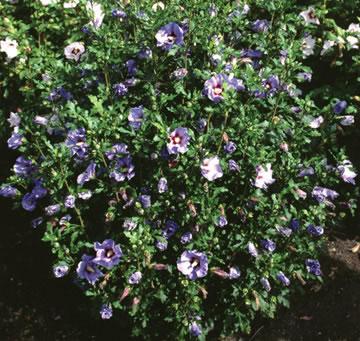 |
| Photo courtesy of Proven Winners - www.provenwinners.com |
|
|
The large, single, rich blue flowers are certain to draw attention in any summer garden. Superior to 'Blue Bird', which is a weak growing plant, Blue Satin is a strong growing, uniform variety with rich color. Unusual blue flowers add a tropical touch to any landscape.
"I just purchased the Rose of Sharon "Blue Satin'. This is the most beautiful hibiscus that I have ever seen. Your plants are always superior. Thank you so much!" - S. Graff - NC
|
|